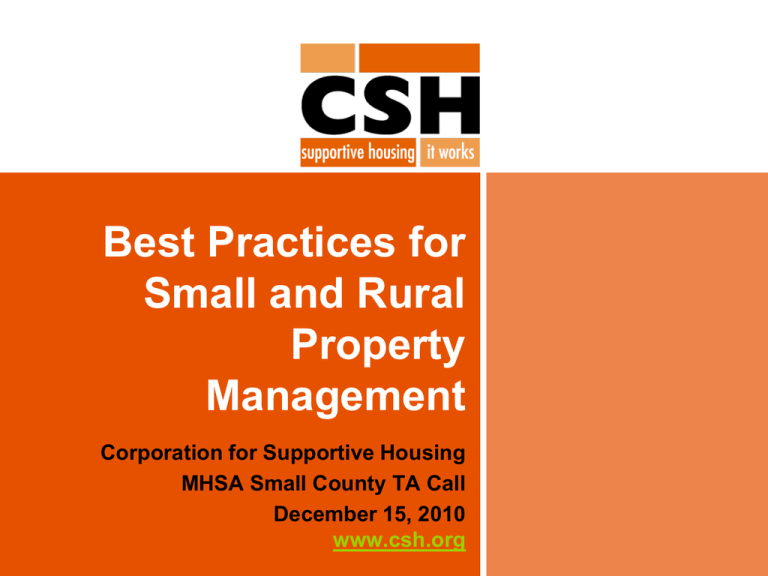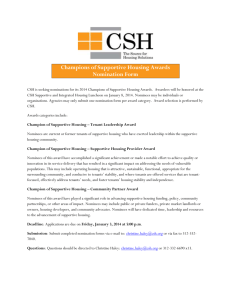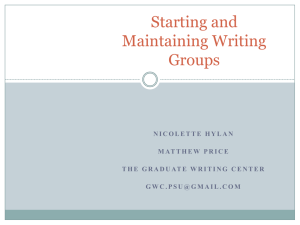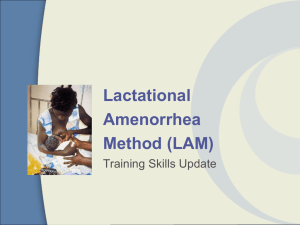Best Practices for Small and Rural Property Management
advertisement

Best Practices for Small and Rural Property Management Corporation for Supportive Housing MHSA Small County TA Call December 15, 2010 www.csh.org Why is PM Different in Small and/or Rural Areas? 2 Economies of scale are elusive for small properties or small portfolios; It is challenging to deploy staff to administer and maintain properties over large geographic areas; Small organizations have less cushion to absorb changing market conditions; Most small counties lack experience managing the Permanent Supportive Housing model. Why is PM Different in Supportive Housing? 3 Property management within the context of supportive housing can be thought of as being responsible for a “double bottom-line” maintaining safe, clean, cost-effective properties while also partnering with supportive services staff to help ensure that at-risk and formerly homeless tenants are able to remain living in the housing successfully. Keys to Property Management Success 4 Organization Goals Portfolio Composition Revenues and Operating Budgets Leadership Staffing and Organizational Design External Relationships Unique Market Opportunities Best Practices: Organizational Goals The best property management organizations: Clearly identify how property management fits with their mission; Align staff, board and leadership to achieve common outcomes for the properties, the residents and the organization; Take pride in their product: strive to be the “best housing in the neighborhood” 5 Best Practices: Portfolio Characteristics Portfolio characteristics impact profitability: Challenging properties may require more revenue than management fees provide. Geographic concentration: the smaller the portfolio, the tighter the geographic spread should be. Condition of properties: New or newly acquired properties should be in good condition. Reserves: Properties must have adequate reserves to sustain them. 6 Best Practices: Revenues and Operating Budgets 7 Organizations with small portfolios – especially if geographically dispersed – need additional sources of revenue. New property management organizations need funding to cover start-up costs. – Sources of start-up and operating support: • Development fees • Asset management fees • Grant revenue • Fundraising Best Practices: Leadership 8 Strong, hands-on leaders who are deeply involved in operational details; Innovative and flexible; Expressly empowered by their boards, the property owners and their bosses to set standards, policies and procedures across the portfolio. Best Practices: Organizational Design & Staffing 9 Flatter organizational structures work better; Clear assignment of responsibility for property management tasks; Hire for positive attitude; be willing to train; Focus on staff quality, team-building and retention. Staffing rule of thumb: Number of nonmaintenance staff should range from .30 to .45 FTE per property. Best Practices: External Relationships 10 Excellent external relationships were a characteristic of all model firms studied. – Strong relationships with vendors, including prompt payment of vendor invoices. – Strong business relationships with banks, regulatory agencies, courts and municipal services. – Knowledge of and relationships with social services agencies in the community help provide tenants with the best possible range of services. Best Practices: Unique Market Opportunities 11 Most successful organizations are adept at creative responses to market opportunities. Examples: – One small CDC partners with a larger management company for training and technical assistance. – Several companies use resident managers, offering free or reduced rent in exchange for basic janitorial or emergency response services. – One organization helps residents launch businesses to do landscaping, unit turnovers and other custodial work. Operations Strong similarities were observed in how companies organized, deployed and focused their operations. Best Practices: Administration 13 The smaller the properties, the more centralized the administration. Make rent collection and occupancy the top priorities. Keep teams connected with structured and regular meetings. Best Practices: Maintenance 14 Manage maintenance close to the properties. Establish a regular maintenance schedule and stick to it. Conduct regular unit inspections to identify work order priorities. Stock only minimal inventory. Consider residents, part-timers or contractors for custodial work. Establish a single point of contact for work orders. What are the advantages of a small portfolio? 15 A small organization focused on delivering highquality property management services can have a dramatic impact on the quality of a community’s housing. Small organizations can often be more flexible than large ones, reinventing themselves as they grow, and in response to new opportunities. Finally, a skilled, hands-on leader can work wonders with a small portfolio, overcoming the absence of strong systems. High impact solutions The best companies routinely choose solutions to: Optimize curb appeal; Minimize the time required to prepare vacant units for occupancy; Engage the right skill level for the task (i.e., do it right the first time. They are flexible in assessing using in-house staff vs. contracting out based on cost, time and quality. 16 Systems Successful companies adopt standardized systems and customize as appropriate. Property management accounting: general ledger, accounts payable, accounts receivable. Tracking vacancies. Budget and budget monitoring reports. Work management system (can be manual). Regulatory reporting capacity. Annual audit readiness. Personnel, payroll, benefits management. 17 Source of Information 18 “Best Practices for Small and Rural New England Property Management Firms”, Prepared for NeighborWorks America by Judy Weber and Laurie Gould, 2002 Other Resources on Property Management 19 Toolkit for Developing and Operating Supportive Housing, Housing Operations Section Best Practices Manual: Integrating Property Management and Services in Supportive Housing The Seven Dimensions of Quality for Supportive Housing Supportive Housing Property Management Operations Manual All available at www.csh.org For questions on Property Management contact Anne Cory or Alan Saunders at the Corporation for Supportive Housing











